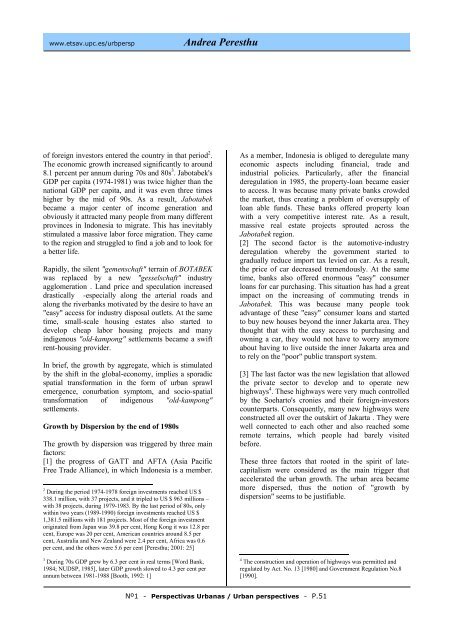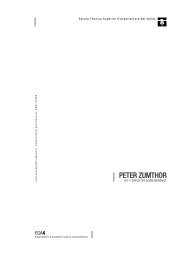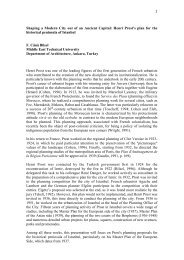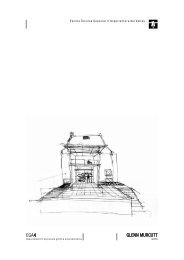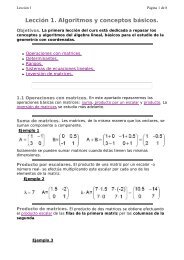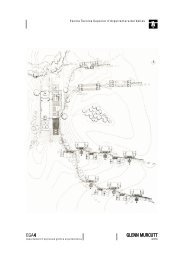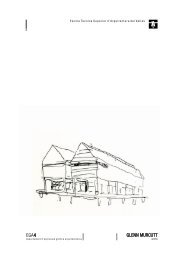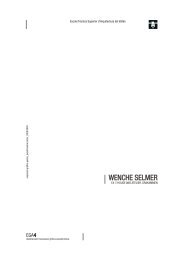You also want an ePaper? Increase the reach of your titles
YUMPU automatically turns print PDFs into web optimized ePapers that Google loves.
www.etsav.upc.es/urbpersp Andrea Peresthu<br />
of foreign investors entered the country in that period 2 .<br />
The economic growth increased significantly to around<br />
8.1 percent per annum during 70s and 80s 3 . Jabotabek's<br />
GDP per capita (1974-1981) was twice higher than the<br />
national GDP per capita, and it was even three times<br />
higher by the mid of 90s. As a result, Jabotabek<br />
became a major center of income generation and<br />
obviously it attracted many people from many different<br />
provinces in Indonesia to migrate. This has inevitably<br />
stimulated a massive labor force migration. They came<br />
to the region and struggled to find a job and to look for<br />
a better life.<br />
Rapidly, the silent "gemenschaft" terrain of BOTABEK<br />
was replaced by a new "gesselschaft" industry<br />
agglomeration . Land price and speculation increased<br />
drastically -especially along the arterial roads and<br />
along the riverbanks motivated by the desire to have an<br />
"easy" access for industry disposal outlets. At the same<br />
time, small-scale housing estates also started to<br />
develop cheap labor housing projects and many<br />
indigenous "old-kampong" settlements became a swift<br />
rent-housing provider.<br />
In brief, the growth by aggregate, which is stimulated<br />
by the shift in the global-economy, implies a sporadic<br />
spatial transformation in the form of urban sprawl<br />
emergence, conurbation symptom, and socio-spatial<br />
transformation of indigenous "old-kampong"<br />
settlements.<br />
Growth by Dispersion by the end of 1980s<br />
The growth by dispersion was triggered by three main<br />
factors:<br />
[1] the progress of GATT and AFTA (Asia Pacific<br />
Free Trade Alliance), in which Indonesia is a member.<br />
2 During the period 1974-1978 foreign investments reached US $<br />
338.1 million, with 37 projects, and it tripled to US $ 963 millions –<br />
with 38 projects, during 1979-1983. By the last period of 80s, only<br />
within two years (1989-1990) foreign investments reached US $<br />
1,381.5 millions with 181 projects. Most of the foreign investment<br />
originated from Japan was 39.8 per cent, Hong Kong it was 12.8 per<br />
cent, Europe was 20 per cent, American countries around 8.5 per<br />
cent, Australia and New Zealand were 2.4 per cent, Africa was 0.6<br />
per cent, and the others were 5.6 per cent [Peresthu; 2001: 25]<br />
3 During 70s GDP grew by 6.3 per cent in real terms [Word Bank,<br />
1984; NUDSP, 1985], later GDP growth slowed to 4.3 per cent per<br />
annum between 1981-1988 [Booth, 1992: 1]<br />
As a member, Indonesia is obliged to deregulate many<br />
economic aspects including financial, trade and<br />
industrial policies. Particularly, after the financial<br />
deregulation in 1985, the property-loan became easier<br />
to access. It was because many private banks crowded<br />
the market, thus creating a problem of oversupply of<br />
loan able funds. These banks offered property loan<br />
with a very competitive interest rate. As a result,<br />
massive real estate projects sprouted across the<br />
Jabotabek region.<br />
[2] The second factor is the automotive-industry<br />
deregulation whereby the government started to<br />
gradually reduce import tax levied on car. As a result,<br />
the price of car decreased tremendously. At the same<br />
time, banks also offered enormous "easy" consumer<br />
loans for car purchasing. This situation has had a great<br />
impact on the increasing of commuting trends in<br />
Jabotabek. This was because many people took<br />
advantage of these "easy" consumer loans and started<br />
to buy new houses beyond the inner Jakarta area. They<br />
thought that with the easy access to purchasing and<br />
owning a car, they would not have to worry anymore<br />
about having to live outside the inner Jakarta area and<br />
to rely on the "poor" public transport system.<br />
[3] The last factor was the new legislation that allowed<br />
the private sector to develop and to operate new<br />
highways 4 . These highways were very much controlled<br />
by the Soeharto's cronies and their foreign-investors<br />
counterparts. Consequently, many new highways were<br />
constructed all over the outskirt of Jakarta . They were<br />
well connected to each other and also reached some<br />
remote terrains, which people had barely visited<br />
before.<br />
These three factors that rooted in the spirit of latecapitalism<br />
were considered as the main trigger that<br />
accelerated the urban growth. The urban area became<br />
more dispersed, thus the notion of "growth by<br />
dispersion" seems to be justifiable.<br />
4 The construction and operation of highways was permitted and<br />
regulated by Act. No. 13 [1980] and Government Regulation No.8<br />
[1990].<br />
Nº1 - Perspectivas Urbanas / Urban perspectives - P.51


